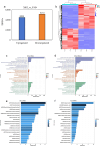Understanding the triacylglycerol-based carbon anabolic differentiation in Cyperus esculentus and Cyperus rotundus developing tubers via transcriptomic and metabolomic approaches
- PMID: 39731027
- PMCID: PMC11681698
- DOI: 10.1186/s12870-024-05999-1
Understanding the triacylglycerol-based carbon anabolic differentiation in Cyperus esculentus and Cyperus rotundus developing tubers via transcriptomic and metabolomic approaches
Abstract
Background: Yellow nutsedge (Cyperus esculentus, known as 'YouShaDou' in China, YSD) and purple nutsedge (Cyperus rotundus, known as 'XiangFuZi' in China, XFZ), closely related Cyperaceae species, exhibit significant differences in triacylglycerol (TAG) accumulation within their tubers, a key factor in carbon flux repartitioning that highly impact the total lipid, carbohydrate and protein metabolisms. Previous studies have attempted to elucidate the carbon anabolic discrepancies between these two species, however, a lack of comprehensive genome-wide annotation has hindered a detailed understanding of the underlying molecular mechanisms.
Results: This study utilizes transcriptomic analyses, supported by a comprehensive YSD reference genome, and metabolomic profiling to uncover the mechanisms underlying the major carbon perturbations between the developing tubers of YSD and XFZ germplasms harvested in Yunnan province, China, where the plant biodiveristy is renowned worldwide and may contain more genetic variations relative to their counterparts in other places. Our findings indicate distinct expression patterns of key regulatory genes involved in TAG biosynthesis and lipid droplet formation, including transcriptional factors and structural genes such as ABI3 transcriptional factor, rate-limiting enzymes GPAT3/6/9 and DGAT2/3, and oleosin and caleosin homologs. Furthermore, our omics data suggest that these differences in gene expression are not the sole contributors to the diverse tuber compositions. Instead, complex interactions among highly regulated catalytic reactions, governing carbohydrate, protein, and species-specific metabolite metabolisms, such as starch and sucrose metabolic pathways, flavonoid and amino acids biosynthetic pathways, collectively contribute to the pronounced carbon anabolic differentiation primarily evident in TAG accumulation, as well as the starch properties in mature tubers.
Conclusion: This study offers new metabolic insights into the high-value underground non-photosynthetic tissues of Cyperaceae species, which harbors not only high biomass productivity but also abundant nutrients as favorable food or industrial sources in the modern agriculture. The detailed omics analyses aim to deepen our understanding of the Cyperaceae species, which may potentially broaden their application values and facilitate the molecular breeding of better varieties to ameliorate the food safety problem.
Keywords: Metabolomics; Purple nutsedge; Transcriptomics; Triacylglycerol; Yellow nutsedge.
© 2024. The Author(s).
Conflict of interest statement
Declarations. Ethics approval and consent to participate: All the methods involving plants, and their materials complied with relevant institutional, local and national regulations.We have obtained the permission from the land managers for taking samples in the areas where YSD (Baoshan district) and XFZ (Jianshui district) grown, respectively. Consent for publication: Not applicable. Competing interests: The authors declare no competing interests. Clinical trial numbe: Not applicable.
Figures








Similar articles
-
Comparative transcriptome analysis of Cyperus esculentus and C. rotundus with contrasting oil contents in tubers defines genes and regulatory networks involved in oil accumulation.Plant Sci. 2024 Nov;348:112230. doi: 10.1016/j.plantsci.2024.112230. Epub 2024 Aug 16. Plant Sci. 2024. PMID: 39154894
-
Sucrose metabolism in developing oil-rich tubers of Cyperus esculentus: comparative transcriptome analysis.BMC Plant Biol. 2018 Jul 24;18(1):151. doi: 10.1186/s12870-018-1363-9. BMC Plant Biol. 2018. PMID: 30041609 Free PMC article.
-
Oil Biosynthesis in Underground Oil-Rich Storage Vegetative Tissue: Comparison of Cyperus esculentus Tuber with Oil Seeds and Fruits.Plant Cell Physiol. 2016 Dec;57(12):2519-2540. doi: 10.1093/pcp/pcw165. Epub 2016 Oct 13. Plant Cell Physiol. 2016. PMID: 27742886
-
Cyperus rotundus L.: Traditional uses, phytochemistry, and pharmacological activities.J Ethnopharmacol. 2015 Nov 4;174:540-60. doi: 10.1016/j.jep.2015.08.012. Epub 2015 Aug 20. J Ethnopharmacol. 2015. PMID: 26297840 Review.
-
Cyperus (Cyperus esculentus L.): A Review of Its Compositions, Medical Efficacy, Antibacterial Activity and Allelopathic Potentials.Plants (Basel). 2022 Apr 21;11(9):1127. doi: 10.3390/plants11091127. Plants (Basel). 2022. PMID: 35567128 Free PMC article. Review.
Cited by
-
Insights into the Stearoyl-Acyl Carrier Protein Desaturase (SAD) Family in Tigernut (Cyperus esculentus L.), an Oil-Bearing Tuber Plant.Plants (Basel). 2025 Feb 14;14(4):584. doi: 10.3390/plants14040584. Plants (Basel). 2025. PMID: 40006843 Free PMC article.
-
Insights into membrane-bound fatty acid desaturase genes in tigernut (Cyperus esculentus L.), an oil-rich tuber plant in Cyperaceae.BMC Plant Biol. 2025 Mar 26;25(1):382. doi: 10.1186/s12870-025-06398-w. BMC Plant Biol. 2025. PMID: 40133805 Free PMC article.
References
-
- Babiaka SB, Moumbock AFA, Günther S, Ntie-Kang F. (2021) Natural products in Cyperus rotundus L. (Cyperaceae): An update of the chemistry and pharmacological activities. RSC Advances 11 (25):15060–15077. 10.1039/d1ra00478f
MeSH terms
Substances
Grants and funding
- 202403AP140013/Project of The Sino-Vietnamese International Joint Laboratory for Characteristic & Cash Crops Green Development of Yunnan Province
- 202403AP140013/Project of The Sino-Vietnamese International Joint Laboratory for Characteristic & Cash Crops Green Development of Yunnan Province
- 2022ZHNY06/Normal Project of the Key Laboratory for Crop Production and Smart Agriculture of Yunnan Province
- 202201AU070186/Fundamental Research Project for Youth of Yunnan Province
LinkOut - more resources
Full Text Sources

